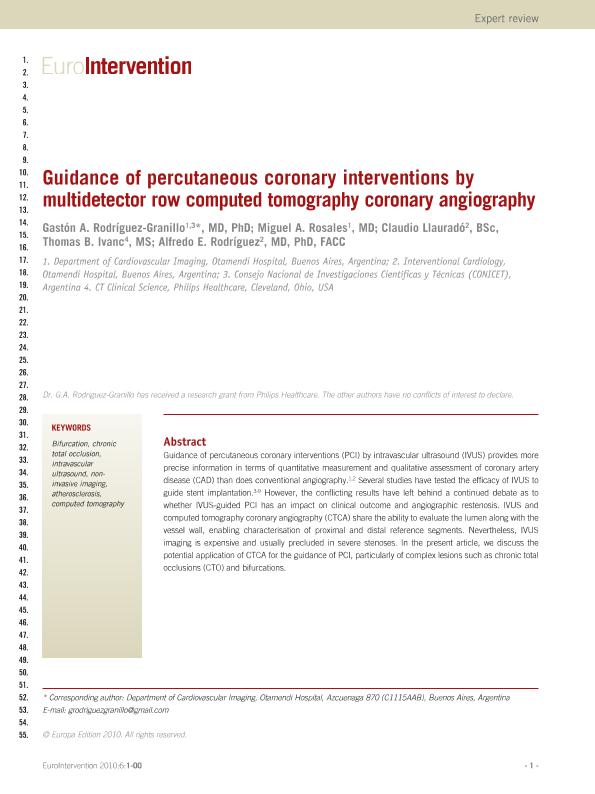Artículo
Guidance of Percutaneous Coronary Interventions by Multidetector Row Computed Tomography Coronary Angiography
Rodriguez Granillo, Gaston Alfredo ; Rosales, Miguel A.; Llauradó, Claudio; Ivanc, Thomas B.; Rodríguez, Alfredo E.
; Rosales, Miguel A.; Llauradó, Claudio; Ivanc, Thomas B.; Rodríguez, Alfredo E.
 ; Rosales, Miguel A.; Llauradó, Claudio; Ivanc, Thomas B.; Rodríguez, Alfredo E.
; Rosales, Miguel A.; Llauradó, Claudio; Ivanc, Thomas B.; Rodríguez, Alfredo E.
Fecha de publicación:
01/2011
Editorial:
European Association of Percutaneous Cardiovascular Interventions
Revista:
Eurointervention
ISSN:
1774-024X
Idioma:
Inglés
Tipo de recurso:
Artículo publicado
Clasificación temática:
Resumen
Guidance of percutaneous coronary interventions (PCI) by intravascular ultrasound (IVUS) provides more precise information in terms of quantitative measurement and qualitative assessment of coronary artery disease (CAD) than does conventional angiography.1,2 Several studies have tested the efficacy of IVUS to guide stent implantation.3-9 However, the conflicting results have left behind a continued debate as to whether IVUS-guided PCI has an impact on clinical outcome and angiographic restenosis. IVUS and computed tomography coronary angiography (CTCA) share the ability to evaluate the lumen along with the vessel wall, enabling characterisation of proximal and distal reference segments. Nevertheless, IVUS imaging is expensive and usually precluded in severe stenoses. In the present article, we discuss the potential application of CTCA for the guidance of PCI, particularly of complex lesions such as chronic total occlusions (CTO) and bifurcations.1,2 Several studies have tested the efficacy of IVUS to guide stent implantation.3-9 However, the conflicting results have left behind a continued debate as to whether IVUS-guided PCI has an impact on clinical outcome and angiographic restenosis. IVUS and computed tomography coronary angiography (CTCA) share the ability to evaluate the lumen along with the vessel wall, enabling characterisation of proximal and distal reference segments. Nevertheless, IVUS imaging is expensive and usually precluded in severe stenoses. In the present article, we discuss the potential application of CTCA for the guidance of PCI, particularly of complex lesions such as chronic total occlusions (CTO) and bifurcations.3-9 However, the conflicting results have left behind a continued debate as to whether IVUS-guided PCI has an impact on clinical outcome and angiographic restenosis. IVUS and computed tomography coronary angiography (CTCA) share the ability to evaluate the lumen along with the vessel wall, enabling characterisation of proximal and distal reference segments. Nevertheless, IVUS imaging is expensive and usually precluded in severe stenoses. In the present article, we discuss the potential application of CTCA for the guidance of PCI, particularly of complex lesions such as chronic total occlusions (CTO) and bifurcations.
Archivos asociados
Licencia
Identificadores
Colecciones
Articulos(SEDE CENTRAL)
Articulos de SEDE CENTRAL
Articulos de SEDE CENTRAL
Citación
Rodriguez Granillo, Gaston Alfredo; Rosales, Miguel A.; Llauradó, Claudio; Ivanc, Thomas B.; Rodríguez, Alfredo E.; Guidance of Percutaneous Coronary Interventions by Multidetector Row Computed Tomography Coronary Angiography; European Association of Percutaneous Cardiovascular Interventions; Eurointervention; 6; 6; 1-2011; 773-778
Compartir



